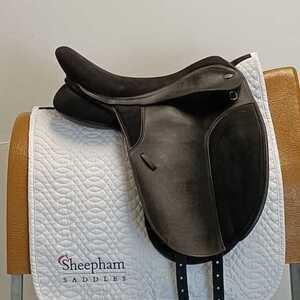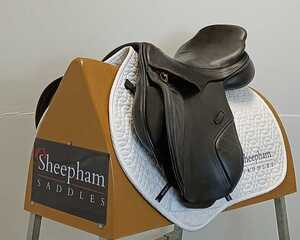Help and advice
Optimal Saddle Placement For Your Horse – A Guide For Riders
Finding the right saddle is only part of ensuring a comfortable and effective ride. Correct saddle placement is just as important, as an improperly positioned saddle can cause discomfort, restrict movement, and even lead to long-term issues for your horse. Understanding where a saddle should sit on your horse and how to check for a proper fit can make all the difference in your horse’s wellbeing and your overall riding experience.
In this guide, we’ll explore the key principles of saddle placement, common fitting mistakes, and how to ensure your saddle is positioned correctly for balance, stability, and comfort.

Ensuring proper placement
Why correct saddle positioning matters
A well-placed saddle allows your horse to move freely while providing the support needed for both horse and rider. The saddle should distribute weight evenly, avoiding pressure points that can lead to soreness or resistance. If the saddle is too far forward, it may interfere with the shoulder, restricting movement and causing discomfort. If it sits too far back, it can place pressure on the lumbar region, leading to pain and possible long-term damage.
To ensure the best placement, always start by identifying key anatomical landmarks. The front of the saddle should sit just behind the scapula (shoulder blade), allowing the shoulder to move naturally. The back of the saddle must not extend past the last rib, as this would place unnecessary strain on the horse’s back.
Achieving correct position
Checking wither clearance and gullet space
Wither clearance is a key consideration when assessing saddle placement. A correctly fitting saddle should have at least two to three fingers of space between the pommel and the horse’s wither. There should also be adequate clearance on either side of the wither to prevent pinching.
The gullet channel should provide enough space to prevent direct contact with the spine, ensuring even weight distribution. If the gullet is too narrow, the saddle may press on the spine, causing discomfort and potential injury. If it is too wide, the saddle may become unstable and rock from side to side.
To help riders achieve the correct fit as the horse’s shape changes, saddles like the Thorowgood T4 Dressage 17" Adjustable Black are an exceptional investment as they feature an adjustable gullet system.

Saddle fitting basics
Understanding tree points and balance
The tree points of the saddle should sit behind the scapula, running parallel to the horse’s body. This allows freedom of movement and prevents interference with the shoulder. A poorly positioned saddle can lead to uneven weight distribution, which may cause discomfort or hinder performance.
Balance is another important aspect of saddle fit. A well-fitted saddle should sit level on the horse’s back, with the cantle and pommel aligned. If the saddle tips forward, it may indicate it is too wide, causing excessive pressure on the front panels. If it tips backward, it may be too narrow, leading to restricted movement and discomfort.
For horses with high withers, models such as the Kent & Masters High Wither Compact GP 17.5" Adjustable Brown provide tailored support with a well-balanced panel and a slightly flatter underside.
Saddle placement tips
Finding the right length
The length of a saddle is another fundamental concern. A saddle should never extend beyond the last rib (T18), as this would put pressure on the lumbar region, an area that lacks the support needed to carry weight comfortably. Horses with shorter backs may require saddles with a more compact design to avoid unnecessary pressure.
The Kent & Masters Pony GP Saddle 16" Adjustable Brown is designed with shorter panels, making it a good choice for ponies and horses with compact backs. Its versatile design ensures correct positioning while maintaining comfort for both horse and rider.
Correcting your position
Avoiding common mistakes with saddle placement
Even with a well-fitting saddle, incorrect placement can lead to issues. As discussed, common mistakes include placing the saddle too far forward, which can restrict shoulder movement and cause discomfort, or allowing the saddle to slip backwards, leading to instability and excess pressure on the horse’s back.
Riders should always check for even contact between the saddle panels and the horse’s back. Running a hand underneath the panels while the saddle is ungirthed and girthed can help detect any pressure points, lumps, or bridging, which occurs when the panels lose contact in the middle, creating pressure at the front and back.

Positioning the saddle
The importance of girthing
Once the saddle is correctly placed, securing it with the right girthing method is essential for stability. Many modern saddles offer adjustable girthing options to ensure a secure fit while maintaining comfort. A well-positioned girth should not pull the saddle forward or cause uneven pressure.
The Albion K2 Jump Saddle 17.5" MW Black features fixed front and rear blocks, providing additional stability while maintaining a secure fit. This is particularly beneficial for jumping, where balance and positioning are critical.
Key considerations for fitting
Trialling a saddle for the best fit
Even with all the right measurements, there is no substitute for testing a saddle in real-world conditions. A saddle that seems well-positioned while static may shift or cause discomfort once the horse is in motion.
At Sheepham Saddles, every saddle comes with a 5-day UK trial, giving riders the chance to assess fit and comfort through multiple riding sessions. This allows time to check saddle balance, stability, and overall performance before making a final decision.
If the saddle doesn’t provide the right fit, our returns process ensures that you can explore other options until you find the best match for your horse.
How can we help?
Achieving the correct saddle placement is essential for your horse’s comfort and overall performance. The right positioning allows for freedom of movement, ensures even weight distribution, and helps maintain rider balance.
At Sheepham Saddles, we offer expert advice and a carefully curated selection of second-hand saddles to help you find the perfect fit.
Browse our range of quality used saddles or contact us for any guidance on choosing the best saddle for your horse.
Posted on March 11th 2025

